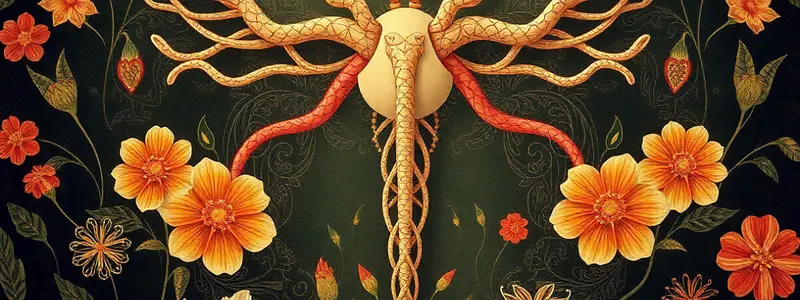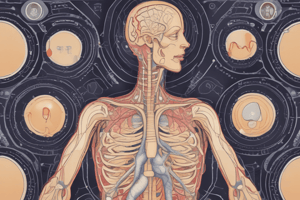Podcast
Questions and Answers
What are the major functions of the endocrine system?
What are the major functions of the endocrine system?
Controls and coordinates body’s response to changes in environment using hormones and performs bodily regulation using glands and hormones.
Which gland is responsible for maintaining the body’s homeostasis and regulating temperature, heart rate, and blood pressure?
Which gland is responsible for maintaining the body’s homeostasis and regulating temperature, heart rate, and blood pressure?
- Pituitary Gland
- Adrenal Gland
- Hypothalamus (correct)
- Thymus
Match each hormone to its corresponding gland:
Match each hormone to its corresponding gland:
Melatonin = Pineal Gland Insulin = Pancreas Estrogen = Ovaries Testosterone = Testes
What type of hormones bind to receptor proteins on the cell membrane surface?
What type of hormones bind to receptor proteins on the cell membrane surface?
What are the two types of hormones released by the posterior pituitary?
What are the two types of hormones released by the posterior pituitary?
Which of the following interactions occurs when two hormones amplify the same effects in a target cell?
Which of the following interactions occurs when two hormones amplify the same effects in a target cell?
List the four distinct processes that must occur for respiration.
List the four distinct processes that must occur for respiration.
What type of cells are Type I alveolar cells responsible for?
What type of cells are Type I alveolar cells responsible for?
According to Boyle's Gas Law, the pressure and volume of a gas have an inverse relationship. When the volume of a gas increases, its ____ decreases.
According to Boyle's Gas Law, the pressure and volume of a gas have an inverse relationship. When the volume of a gas increases, its ____ decreases.
What does the Ideal Gas Law formula represent?
What does the Ideal Gas Law formula represent?
Flashcards are hidden until you start studying
Study Notes
Endocrine System Functions
- Controls and coordinates the body's response to environmental changes using hormones.
- Regulates bodily functions using glands and hormones.
Major Endocrine Glands
- Hypothalamus: Maintains homeostasis, regulates temperature, heart rate, and blood pressure.
- Pituitary Gland: Composed of two lobes:
- Anterior: Secretes hormones for growth and development.
- Posterior: Secretes hormones that increase water reabsorption in the kidneys.
- Pineal Gland: Produces melatonin, which regulates the sleep-wake cycle.
- Thyroid Gland: Produces three hormones:
- Calcitonin: Regulates calcium levels in the blood.
- Triiodothyronine (T3): Regulates metabolism and energy production.
- Thyroxine (T4): Regulates metabolism and energy production.
- Parathyroid Gland: Secretes hormones essential for calcium absorption.
- Thymus: Controls the production of T-cells, white blood cells crucial for fighting diseases.
- Ovaries & Testes: Release hormones affecting blood circulation, mental vigor, and sex drive.
- Ovaries: Secrete estrogen and progesterone, vital for the female reproductive system.
- Testes: Secrete testosterone, essential for physical development, bone density, and libido.
- Pancreas: Aids in digestion of proteins, fats, and carbohydrates. Produces insulin and glucagon, which regulate blood glucose levels.
- Adrenal Gland: Produces adrenaline and cortisol, enabling the body to respond to stress.
Hormone Binding and Cellular Effects
- Protein Hormones (Peptide Hormones): Bind to receptor proteins on cell membrane surfaces.
- Binding triggers chemical reactions involving "second messengers" (e.g., calcium ions (Ca2+) and cyclic AMP (cAMP)).
- Second messengers activate or inactivate enzymes, affecting cellular processes.
- Steroid (Lipid) Hormones: Bind to receptor proteins in the cytoplasm or nucleus of target cells.
- Derived from cholesterol.
- Form a "hormone-receptor complex" within the cell.
- This complex acts as a transcription factor, influencing DNA expression and protein synthesis.
- Amino Acid Derived Hormones: Bind to cell surface membrane receptors.
- Derived from modifications of tyrosine or tryptophan molecules.
- Binding activates secondary proteins or enzymes in the membrane (e.g., G-proteins).
- Activates second (and sometimes third) messenger systems (e.g., cAMP or Ca2+), leading to a cellular response.
Pituitary Hormones
- Posterior Pituitary: Releases two peptide hormones:
- Oxytocin: Involved in uterine contractions and milk ejection.
- Vasopressin (ADH): Regulates water reabsorption in the kidneys.
- Anterior Pituitary: Releases six hormones:
- Prolactin (PRL): Stimulates milk production.
- Thyrotropin (TSH): Stimulates the thyroid gland.
- Adrenocorticotropin (ACTH): Stimulates the adrenal gland.
- Growth Hormone (GH): Promotes growth and development.
- Follicle-stimulating hormone (FSH): Regulates egg and sperm production.
- Luteinizing hormone (LH): Regulates ovulation and testosterone production.
Hormone Interaction
- Synergism: Two or more hormones produce the same effects, amplifying the overall response.
- Permissiveness: One hormone requires the presence of another to exert its full effect.
- Antagonism: One hormone opposes or reverses the effect of another.
Respiratory System Functions
- Facilitates gas exchange between air and circulating blood.
- Moves air in and out of the lungs.
- Protects respiratory surfaces from the external environment.
- Produces sound.
- Contributes to the sense of smell (olfactory).
Alveolar Cells
- Type I: Simple squamous cells where gas exchange occurs.
- Type II (Septal Cells): Secretes alveolar fluid containing surfactant, which reduces surface tension in the alveoli.
- Alveolar Dust Cells: Macrophages that remove debris from the alveoli.
Processes of Respiration
- Pulmonary Ventilation: Movement of air in and out of the lungs (inhalation/inspiration and exhalation/expiration).
- External Respiration: Gas exchange between the lungs and blood capillaries.
- Transport of Gases: Oxygen and carbon dioxide travel to and from tissue cells.
- Internal Respiration: Gas exchange between blood capillaries and tissue cells.
Gas Laws
- Ideal Gas Law: PV = nRT (describes the relationship between pressure, volume, temperature, and the number of moles of a gas).
- Boyle's Gas Law: The pressure and volume of a gas are inversely related.
- Increased volume lowers pressure, allowing air to flow into the lungs.
- Decreased volume raises pressure, forcing air out of the lungs.
Studying That Suits You
Use AI to generate personalized quizzes and flashcards to suit your learning preferences.




